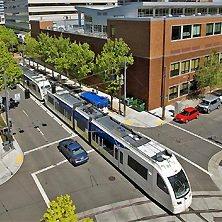
At the recent Rail~Volution conference in Dallas, the Rail~Volution organization and six Federal Reserve banks (Atlanta, Dallas, Kansas City, Philadelphia, Richmond, and San Francisco) joined with Enterprise Community Partners, the Local Initiatives Support Corporation (LISC), and the Low-Income Investment Fund (LIIF) to host a symposium on exploring, promoting, and implementing equitable transit-oriented development (ETOD). Attendees included representatives from local government, affordable housing, city planning, transit agencies, financial institutions, the philanthropic community, and community-based organizations.
Learning sessions were planned around health, funding, regional collaboration, and engagement, among other topics. A session on gentrification convened a diverse group of experts from Denver, Dallas, Philadelphia, St. Paul, Chicago, and Washington, D.C. The discussion centered on the challenges of providing transit access and transit-oriented neighborhood revitalization without displacing residents.
Gentrification, or the increase in property values and consequential demographic shift in household incomes, can provide positive place-based neighborhood effects such as social amenities for residents. However, involuntary displacement is a negative people-based outcome, as existing residents are priced out of a neighborhood, with subsequent generations unable to remain there. These forces reduce social capital, destabilize households and communities, and promote polarization rather than diversity and inclusion.
Transit access is beneficial for low- and moderate-income households and regions; public transportation can reduce household transportation costs, provides improved access to employment and amenities, stabilizes ridership and revenue of transit authorities, and improves regional air quality and congestion.
Many cities have experienced strong upward market pressure around transit stations. According to research by Louisiana State University's Michael S. Barton and San Diego State University's Joseph Gibbons, in New York City high-income households tend to locate near rapid transit stations, while low-income households tend to locate near bus stops. This pressure threatens long-term affordability near train and subway stations. Accordingly, Los Angeles has explicitly cited the loss in ridership as an impetus to its new commitment to 35 percent affordable units on its Metro-owned land. Ian Carlton, founder of Ian Carlton Research and Consulting and one of the symposium's keynote speakers, cited his and Miriam Zuk's findings that over the past two decades, limited progress has been made in deliberately locating affordable housing near transit using Low Income Housing Tax Credit (LIHTC) subsidies. The cost of land remains an imposing deterrent to developing ETODs in opportunity-rich neighborhoods.
In response to these challenges, host agencies facilitated an "idea lab" at the Rail~Volution event, which included roundtable forums on mitigating gentrification and displacement around ETOD sites and a deep-dive conversation on gentrification and community engagement.
Roundtable forums
Three major themes emerged from the roundtable discussions.
- First, the issues of gentrification and displacement are complex and multifaceted. Thus, the appropriate solutions and tools vary significantly by location, such as between postindustrial and high-growth cities. Strikingly, some regions highlighted innovative and effective approaches like tenant opportunity-to-purchase agreements and ordinances, while others noted the lack of political will to move ETOD initiatives forward. Other approaches included community land trusts with a particular emphasis on early acquisition of land in gentrifying neighborhoods and the leveraging of partnerships between nonprofits, private developers, local and regional government, and others.
- The second theme concerned indicators and assessments. Conducting appropriate assessments and understanding the data before shaping policy is important. Participants noted that a community should have a full understanding of an issue before initiating policies to address it. For example, the University of Illinois Voorhees Center for Neighborhood and Community Improvement completed a gentrification index
 to better understand and address neighborhood change in the Chicago region.
to better understand and address neighborhood change in the Chicago region. - A third theme was that community engagement is important to ensure that growth is inclusive and benefits all residents. Community engagement strategies should include both residents and businesses, which are also vulnerable to displacement and are necessary for maintaining continuity and sense of place.
Deep-dive discussion
Building on discussions about community engagement during the roundtables, the deep-dive conversation highlighted opportunities to mitigate displacement with community engagement. During the session, a panel of experts, including Jeanne DuBois of the Dorchester Bay Economic Development Corporation, Meredith Levy of the Summerville Community Corporation, and Dick Voith of Econsult Solutions, gave perspectives on their own involvement in these issues. Community organizing was highlighted, including the difficulties in relationship and trust building and the need to act decisively as a community. In the panelists' experiences, funding for organizing has been successfully sought from their respective local philanthropic communities. The civic community, including faith-based organizations, can also be leveraged. This discussion further elucidated approaches for mitigating displacement, including just-cause eviction protection, rent stabilization, strategies to understand the speculative real estate market, linkage fees for workforce development and affordable housing, community benefits agreements, and crowd sourcing (an example being the recent Gentrification Learning Community cosponsored by Boston LISC). Forum attendees also noted that a toolkit or portal is needed to capture the existing knowledge base and assist communities facing gentrification pressures.
The ETOD symposium highlighted a number of issues with which communities continue to struggle and offered emerging strategies and innovative approaches to address the issues. The Federal Reserve System has begun to build a peer-learning community to share ideas around this important topic and we look forward to continuing to partner with our stakeholders to further this dialogue. To this end, please reach out to Ann Carpenter of the Atlanta Fed to receive information about future events and opportunities.
By Ann Carpenter, Atlanta Fed CED adviser, and Erin Mierzwa![]() , Philadelphia Fed Community Development department manager
, Philadelphia Fed Community Development department manager
References
Barton, M. S., & Gibbons, J. (2015). "A Stop Too Far: How Does Public Transportation Concentration Influence Neighbourhood Median Household Income?" Urban Studies, 1–17.
Zuk, M., & Carlton, I. (2015). Equitable Transit Oriented Development: Examining the Progress and Continued Challenges of Developing Affordable Housing in Opportunity and Transit-Rich Neighborhoods. Poverty & Race Research Action Center.



